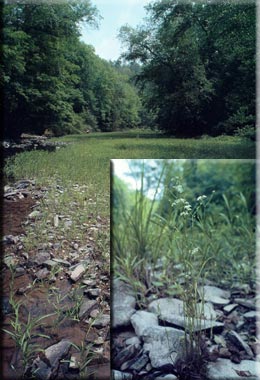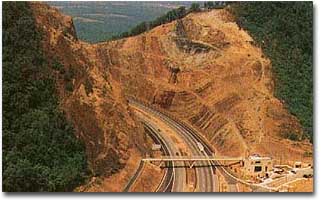The overriding goal of the Sideling Hill WMA in eastern Allegany and western Washington Counties is to provide forest wildlife habitat and protection for water quality in Sideling Hill Creek. Dramatic rock formations include scenic cliffs and rocky outcrops of Devonian shale and Chemung and Hampshire sandstone. The steep shale barrens along sections of Sideling Hill Creek support a number of plants that are endemic, meaning they only occur on these barrens and nowhere else. In 1986, DNR identified Natural Heritage Areas on this WMA, affording protection to a large number of rare, threatened or endangered plants, including the State and Federally Endangered plant, Harperella (Ptilimnium nodosum) pictured here.
Allegany and western Washington Counties is to provide forest wildlife habitat and protection for water quality in Sideling Hill Creek. Dramatic rock formations include scenic cliffs and rocky outcrops of Devonian shale and Chemung and Hampshire sandstone. The steep shale barrens along sections of Sideling Hill Creek support a number of plants that are endemic, meaning they only occur on these barrens and nowhere else. In 1986, DNR identified Natural Heritage Areas on this WMA, affording protection to a large number of rare, threatened or endangered plants, including the State and Federally Endangered plant, Harperella (Ptilimnium nodosum) pictured here.
What To See
This 3,100-acre tract of mixed mixed oak forest with scattered stands of Virginia Pine is a must for outdoor enthusiasts who love mountain scenery and wildlife. The property has a rolling to steep topography with elevations ranging from 500 to 1,500 feet. Nearby is the Sideling Hill Visitor's Center, where the geology of the area and of the deepest road cut east of the Mississippi River is fully explored.
What To Do
In the spring, turkey gobblers strut through the forest and forest clearings, displaying their beautiful array of feathers. Black Bears are commonly seen in this area. White-tailed deer, grouse and squirrels will challenge the forest hunter. Anglers will enjoy fishing for stocked trout in the shallow creek. Canoeing is only possible during the spring melt, but canoeing the creek is splendid at that time of year. Old logging roads are scattered throughout Sideling Hill WMA, creating both easy and challenging walks for hunters and hikers.
Area Regulations
- Use of Sideling Hill WMA is generally permitted seven days a week throughout the year
- Hunting is allowed in accordance with open seasons and shooting hours
- No special permits or drawings are required to hunt this area, except appropriate licenses and stamps.
- Trapping by permit only.
Special Areas
 Interesting geologic formations can be viewed where rocky outcrops of Devonian shale and Chemung and Hampshire sandstone cliffs and barrens occur.
Interesting geologic formations can be viewed where rocky outcrops of Devonian shale and Chemung and Hampshire sandstone cliffs and barrens occur. - There is no disabled hunter access available on Sideling Hill WMA, but it is available on adjacent Woodmont NRMA.
- Sideling Hill Creek is home to a number of rare species and habitats, including the State and Federally Endangered plant, Harperella (Ptilimnium nodosum).
- Sideling Hill Visitor Center (not currently open) is on Sideling Hill WMA. Visitors to this unique exhibit center can view rock exposures in the deepest road cut east of the Mississippi River.
Non-hunting Users Guide
- Non-hunting visitors are welcome.
- Be aware of open hunting seasons and visit accordingly
- Season dates available in newspapers, on the Internet, and at some area stores
- Trails are maintained but not actively marked
- Bird watching and hiking are popular uses of this area.
- Hardwood forests surround many of the trails and support a rich variety of song birds and other wildlife species, depending on the time of year.
Site Management Goals
- The overriding goal of this area is to provide forest wildlife habitat and protection for water quality in Sideling Hill Creek.
- This area is managed to provide habitat for game and non-game wildlife species including white-tailed deer, wild turkeys, gray and fox squirrels, ruffed grouse, and songbirds.
- Agricultural fields and small herbaceous wildlife openings are planted and maintained to provide feeding and brood rearing habitat for a variety of wildlife.
Directions
To reach the northern section of Sideling Hill WMA, take I-68 to the Woodmont Road exit. Turn right on MD 144 (National Pike). At the top of the mountain, make a left onto Riser Road into Sideling Hill WMA. To reach the southern section, take the I-68 exit to Woodmont Road. On MD 144, turn left and make an immediate right onto Woodmont Road (MD 453). Follow this route to Pearre Road and turn right. At Allegany County Line Road make another right. Follow this road to the area. For additional information, contact Indian Springs Wildlife Office at (301) 842-2702.
 Click Here for Map
Click Here for Map
Photo of Sideling Hill Creek and Harperella courtesy of R. H. Wiegand.
This area is a part of Maryland’s Department of Natural Resources public land system and is managed by the Wildlife and Heritage Service. The primary mission of the WMA system is to conserve and enhance wildlife populations and their respective habitats as well as to provide public recreational use of the State’s wildlife resources.
Eighty-five percent of the funding for Maryland's state wildlife programs comes from hunting license fees and a federal excise tax on sport hunting devices and ammunition. The federal aid funds are derived from the Federal Aid in Wildlife Restoration (or Pittman-Robertson) Fund, which sportsmen and women have been contributing to since 1937. Each state receives a share of the funds, which is administered by the U. S. Fish and Wildlife Service; these funds are used for wildlife conservation and hunter education programs, including the management of the WMA system.
Other sources of funds for land acquisition include Program Open Space Funding for Maryland's State and local parks and conservation areas, provided through The Department of Natural Resources' Program Open Space. Established in 1969, Program Open Space symbolizes Maryland's long-term commitment to conserving natural resources while providing exceptional outdoor recreation opportunities.